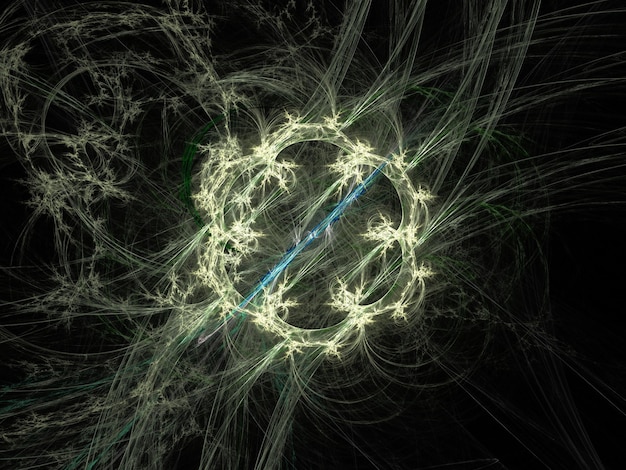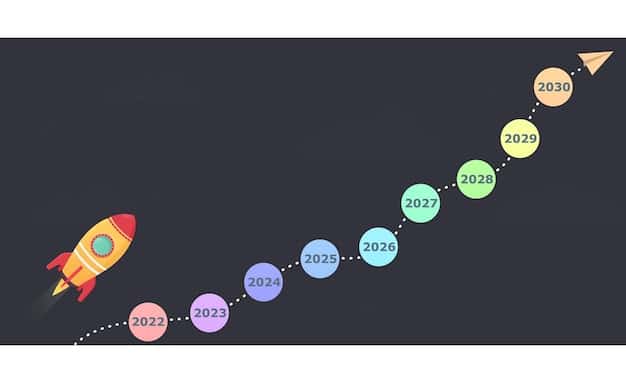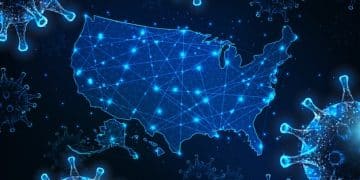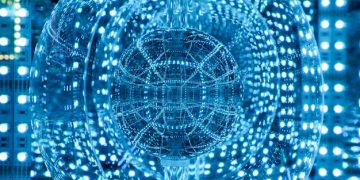Quantum Computing’s 2025 Impact on US Cybersecurity Unveiled

By 2025, quantum computing is anticipated to profoundly reshape US cybersecurity, introducing both unprecedented encryption vulnerabilities and revolutionary defensive capabilities, necessitating immediate strategic adaptation from governmental and private sectors.
The dawn of quantum computing promises to revolutionize countless aspects of technology, yet its imminent arrival casts a particularly complex shadow over the realm of cybersecurity. As we approach 2025, understanding how will quantum computing impact US cybersecurity by 2025 becomes not just an academic exercise, but an urgent strategic imperative for the United States. This transformative technology, while still in its nascent stages, holds the potential to both dismantle current cryptographic foundations and forge impenetrable new defenses.
Understanding the Quantum Threat Landscape
The core of the quantum threat to cybersecurity lies in its ability to break classical encryption algorithms. While universal fault-tolerant quantum computers (FTQCs) are still some years away, the computational advancements by 2025 could already begin to undermine current security protocols, particularly those based on asymmetric cryptography. This impending shift demands a rapid re-evaluation of how sensitive data is protected, both in transit and at rest.
The Shor’s Algorithm Challenge
One of the most widely discussed quantum algorithms, Shor’s algorithm, poses a significant threat to widely used public-key cryptography schemes. These schemes, such as RSA and Elliptic Curve Cryptography (ECC), form the backbone of secure communications, digital signatures, and financial transactions.
- 🔓 RSA Encryption: Many modern secure communications, banking, and e-commerce rely on the difficulty of factoring large numbers, a task Shor’s algorithm can perform efficiently.
- 🔑 ECC Security: While more efficient than RSA for equivalent security levels, ECC also derives its strength from discrete logarithm problems, which quantum computers could solve rapidly.
- 📝 Digital Certificates: The entire Public Key Infrastructure (PKI) that authenticates websites and users is vulnerable, potentially leading to widespread impersonation and data breaches.
The implications extend beyond just breaking current encryption. The ability to decrypt past communications, often referred to as “harvest now, decrypt later,” is a terrifying prospect. Adversaries could be collecting encrypted data today, anticipating the computational power of future quantum machines to unlock it. This necessitates a proactive approach to protecting long-term secrets, such as national security intelligence, intellectual property, and critical infrastructure data. The race is on to develop and deploy post-quantum cryptography (PQC) solutions before this scenario becomes a reality, fundamentally altering the calculus of digital trust.
Emerging Quantum-Resistant Capabilities
While quantum computing presents daunting challenges, it also offers revolutionary opportunities for bolstering cybersecurity. The same principles that empower quantum attacks can be harnessed for superior defensive mechanisms, creating a new paradigm for secure communication and data protection. The development of quantum-resistant algorithms and quantum key distribution (QKD) is crucial in this evolving landscape.
Post-Quantum Cryptography (PQC) Development
Efforts are already well underway to develop cryptographic algorithms that are resistant to attacks from quantum computers. The National Institute of Standards and Technology (NIST) has been leading a global standardization process for PQC algorithms, which is expected to yield initial standards by 2024, impacting US cybersecurity by 2025 with early adoption phases.
- 🛡️ Lattice-based Cryptography: Provides robust security based on hard mathematical problems related to lattices.
- 🌳 Hash-based Signatures: Offers secure digital signatures, providing strong guarantees against quantum attacks.
- 🔢 Code-based Cryptography: Leverages error-correcting codes to achieve quantum resistance.
Beyond PQC, quantum key distribution (QKD) offers an intriguing, fundamentally secure method for exchanging cryptographic keys. Unlike classical methods, QKD relies on the laws of quantum mechanics to detect any eavesdropping attempts during key transmission, making it theoretically impossible for an adversary to intercept the key without detection. While QKD is currently limited by distance and infrastructure requirements, its potential for ultra-secure communications channels for critical national infrastructure and government agencies is immense, with ongoing research aiming to overcome its practical limitations and integrate it into broader networks by 2025.

Governmental and Private Sector Preparedness
The impact of quantum computing on US cybersecurity by 2025 hinges critically on the preparedness of both governmental bodies and private enterprises. A unified, coordinated strategy for transitioning to quantum-resistant solutions is essential to mitigate risks and capitalize on new opportunities. This involves not only technological upgrades but also policy development, workforce training, and international collaboration.
Strategic Initiatives and Mandates
The US government recognizes the quantum threat, and various agencies are already initiating programs to address it. The National Quantum Initiative Act, signed into law in 2018, aims to accelerate quantum information science and technology development. By 2025, we can expect further executive orders and legislative actions to mandate the adoption of PQC standards across federal agencies and critical infrastructure.
Government agencies will likely prioritize the transition of sensitive data and communications to PQC. This involves not only software upgrades but also significant hardware overhauls in some cases, demanding careful planning and substantial investment. The sheer scale of this undertaking requires a phased approach, identifying systems most at risk and implementing solutions proactively. Furthermore, securing the supply chain for quantum-resistant components and software will be paramount to prevent vulnerabilities from being introduced at foundational levels.
Private Sector Engagement
The private sector, particularly industries handling sensitive data like finance, healthcare, and technology, must also accelerate their quantum readiness. Collaboration between government and industry is vital for sharing threat intelligence, developing best practices, and fostering an ecosystem of quantum cybersecurity solutions.
- 💰 Financial Institutions: Protecting customer data and transaction integrity from quantum attacks is a top priority, requiring early adoption of PQC.
- 🏥 Healthcare Systems: Safeguarding patient records and medical research with quantum-resistant encryption is crucial for privacy and security.
- 💻 Tech Companies: Software and hardware developers must integrate PQC into their products and services to ensure future compatibility and security.
By 2025, pioneering companies might begin offering “quantum-safe” products and services, creating a new market segment within cybersecurity. However, the challenge for many private entities will be resource allocation, as developing and implementing quantum-resistant solutions requires specialized expertise and significant financial investment. Education and awareness campaigns will be crucial for convincing businesses of all sizes of the urgent need for quantum cybersecurity planning.
Key Sectors and Their Vulnerabilities in 2025
The pervasive nature of current cryptography means that virtually every sector will be impacted by quantum computing’s advancements by 2025. However, some sectors, due to the nature and sensitivity of their data, or their reliance on legacy systems, face more immediate and profound vulnerabilities. Understanding these specific exposures is critical for targeted mitigation efforts and resource allocation.
Critical Infrastructure and National Security
Networks underpinning critical infrastructure—energy grids, water supply, transportation systems, and communication networks—are particularly vulnerable. A quantum attack on these systems could lead to catastrophic disruption, impacting national security and public safety. By 2025, nation-state actors could be exploring quantum capabilities to gain a strategic advantage, making rapid hardening of these systems a top priority.
National security agencies, dealing with highly classified information with long-term sensitivity, face an immediate “harvest now, decrypt later” threat. Data collected today could be decrypted by 2025 or shortly thereafter using more advanced quantum machines. This necessitates an immediate transition to quantum-resistant encryption for any data deemed critical for national defense and intelligence operations, even if the primary quantum threat is beyond 2025.
Financial and Healthcare Data
The financial sector relies heavily on robust encryption for transactions, customer data, and inter-bank communications. A breach of these systems due to quantum capabilities could devastate global financial markets and erode public trust. Similarly, healthcare organizations protect vast amounts of highly sensitive personal health information (PHI), which, if compromised, could lead to privacy violations, identity theft, and medical fraud. The long retention periods for medical records mean that even data encrypted today could be at quantum risk years down the line.
By 2025, financial institutions and healthcare providers will be under immense pressure to demonstrate their quantum readiness, possibly driven by regulatory bodies and consumer demand for future-proof security. This will involve not just upgrading encryption algorithms but also assessing the entire digital ecosystem, from legacy systems to cloud environments, for quantum vulnerabilities and implementing a holistic PQC migration strategy.
The Role of International Collaboration and Standards
Cybersecurity is a global challenge, and the advent of quantum computing only underscores the necessity for international cooperation. The impact on US cybersecurity by 2025 will also be influenced by how effectively the United States collaborates with its allies and international standards bodies in addressing the quantum threat. Uncoordinated efforts could lead to incompatible systems and new vulnerabilities, undermining overall global security.
Standardization and Interoperability
The NIST PQC standardization process is a prime example of international collaboration, involving cryptographers and researchers from around the world. The adoption of globally recognized PQC standards is crucial for ensuring interoperability across different systems and national borders. By 2025, initial PQC standards will likely be published, providing a common framework for developers and implementers.
Beyond PQC, international cooperation is also vital for developing best practices for quantum-safe key management, secure hardware, and the integration of quantum technologies into existing security architectures. This includes sharing threat intelligence, coordinating research efforts, and establishing protocols for responding to quantum-related cyber incidents. A fragmented approach would only benefit adversaries, allowing them to exploit weaknesses arising from disparate security implementations.
Diplomacy and Strategic Alliances
Quantum computing has significant geopolitical implications, with nations vying for dominance in quantum technology. Cybersecurity becomes a critical dimension of this competition. The US will need to engage in robust diplomatic efforts with key allies to ensure a united front against quantum threats, sharing expertise and resources to accelerate defensive capabilities.
Bilateral and multilateral agreements focused on quantum cybersecurity research, development, and deployment will be essential. By 2025, we might see initial frameworks for such collaborations, aimed at preventing the weaponization of quantum technology and promoting responsible development. This includes discussions around export controls for critical quantum technologies and intelligence sharing on emerging quantum attack capabilities. The goal is to create a collective defense posture that transcends national boundaries, protecting the interconnected global digital infrastructure from the transformative power of quantum computing.
Mitigation Strategies and Roadmaps for 2025
Given the potential for quantum computing to disrupt US cybersecurity by 2025, clear and actionable mitigation strategies are not just desirable but imperative. These strategies must encompass technological upgrades, policy adaptations, and a fundamental shift in how organizations perceive and manage cryptographic risk. A well-defined roadmap, starting now, is the only way to navigate this transition effectively.
Inventory and Risk Assessment
The first critical step for any organization, public or private, is to conduct a comprehensive inventory of all cryptographic assets and functions. This includes identifying where encryption is used, what algorithms are employed, and the sensitivity of the data they protect. A detailed risk assessment then prioritizes vulnerabilities based on the anticipated timeline for quantum attack capabilities and the longevity of the data’s security requirement.
- 📊 Data Classification: Categorize data by sensitivity and required protection lifespan (e.g., short-term vs. long-term secrets).
- 🧩 Cryptosystem Inventory: Document all encryption algorithms, key lengths, and protocols in use across the entire IT infrastructure.
- ⚠️ Vulnerability Mapping: Identify systems that rely on quantum-vulnerable algorithms (e.g., RSA, ECC) and assess their exposure.
This assessment should also consider the broader cryptographic agility of an organization – how easily can it switch out one cryptographic primitive for another? Systems designed with cryptographic agility in mind will have a significant advantage in adapting to the post-quantum era, whereas brittle, hard-coded implementations will pose greater challenges and costs for migration.
Migration to Post-Quantum Cryptography (PQC)
Once an inventory and risk assessment are complete, the next phase is the phased migration to PQC. This is not a simple “flick of a switch” operation; it’s a complex, multi-year endeavor. By 2025, early adopters within critical sectors and government agencies will likely be implementing pilot programs and initial deployments of PQC solutions, preparing for wider adoption as NIST standards mature.
This migration involves upgrading software, hardware, and protocols across entire networks. It also requires extensive testing to ensure that new PQC algorithms are not only secure but also performant and compatible with existing systems. Training cybersecurity professionals in PQC principles and implementation will be a continuous effort. Furthermore, establishing a quantum-safe supply chain to ensure that hardware and software components are secure from quantum-related tampering will be paramount for robust, end-to-end protection. The shift to quantum-resistant encryption is arguably the largest cryptographic transition in the history of information security, necessitating unprecedented levels of coordination and investment.

The Human Element in Quantum Cybersecurity Preparedness
While technological advancements and strategic policies are crucial, the human element remains foundational to how quantum computing will impact US cybersecurity by 2025. A well-trained, adaptable workforce, combined with an understanding among decision-makers, will be essential for successfully navigating the quantum transition. Without adequate human capital, even the most innovative technologies will fall short.
Workforce Development and Training
The current cybersecurity workforce often lacks specific expertise in quantum mechanics, quantum cryptography, and post-quantum algorithms. Addressing this gap is critical. By 2025, educational institutions, government agencies, and industry leaders should be actively investing in programs to upskill existing cybersecurity professionals and attract new talent to this specialized field. This includes:
- 🎓 Academic Curricula: Integrating quantum cybersecurity into university computer science and engineering programs.
- 📚 Professional Certifications: Developing certifications for post-quantum cryptography implementation and management.
- 🤝 Industry-Government Partnerships: Creating talent pipelines and joint training initiatives to share knowledge and resources.
The complexity of migrating to quantum-safe systems means that every stakeholder, from network administrators to chief information security officers, will need some level of awareness or specialized training. This workforce development is not a one-time event but an ongoing process, as quantum technology continues to evolve rapidly. Encouraging cross-disciplinary collaboration between physicists, mathematicians, and cybersecurity experts will foster innovative solutions.
Leadership Awareness and Strategic Vision
Perhaps most importantly, decision-makers at all levels—from corporate boards to federal cabinet members—must grasp the profound implications of quantum computing. This isn’t merely an IT problem; it’s a strategic risk that affects national security, economic stability, and individual privacy. By 2025, these leaders should be actively championing quantum readiness within their organizations, allocating necessary resources, and integrating quantum cybersecurity into broader strategic planning.
A proactive, rather than reactive, mindset is essential. Leaders need to understand that the “harvest now, decrypt later” threat means that inaction today has consequences tomorrow. They must foster a culture of continuous learning and adaptation, recognizing that the cybersecurity landscape will be fundamentally reshaped by quantum technologies. Effective leadership will bridge the gap between technical experts and organizational strategy, ensuring that the US is not only technologically prepared but also strategically aligned to face the quantum future. This includes promoting public awareness, fostering responsible innovation, and engaging in transparent communication about the challenges and opportunities ahead.
| Key Point | Brief Description |
|---|---|
| 🔓 Quantum Threat | Shor’s algorithm can break asymmetric encryption (RSA, ECC), endangering current digital security and data privacy. |
| 🛡️ Quantum Defenses | Post-Quantum Cryptography (PQC) and Quantum Key Distribution (QKD) offer new ways to secure data. |
| 🏛️ Sector Impact | Critical infrastructure, national security, finance, and healthcare face severe vulnerabilities by 2025. |
| 🌎 Global Response | International collaboration and standardized policies are essential for collective defense against quantum threats. |
Frequently Asked Questions
▼
“Harvest now, decrypt later” refers to adversaries collecting encrypted data today, anticipating that future quantum computers will be powerful enough to decrypt it. By 2025, this is a significant concern for long-term sensitive data, such as national security intelligence or intellectual property, as it means current encryption offers only temporary protection against a future quantum attack.
▼
While universal fault-tolerant quantum computers (FTQCs) capable of breaking widely used encryption are not expected by 2025, significant computational advancements may begin to undermine current cryptographic standards. Preparations, particularly for sensitive long-lived data, are crucial as some current algorithms could be compromised as early as 2025, making proactive measures essential.
▼
Post-Quantum Cryptography (PQC) refers to cryptographic algorithms designed to resist attacks from both classical and quantum computers. It will help by providing new encryption standards that can secure data in a quantum-dominated world. NIST is leading the global standardization effort, with initial PQC standards anticipated to be adopted and integrated by US cybersecurity systems around 2025.
▼
By 2025, sectors most at risk include critical infrastructure (energy, transportation), national security, finance, and healthcare. These sectors handle highly sensitive data, often with long-term value, and rely heavily on existing cryptographic systems that are vulnerable to potential quantum attacks. Proactive migration strategies are vital for these industries to secure their operations.
▼
Organizations should immediately begin by conducting a comprehensive inventory and risk assessment of their cryptographic assets. This involves identifying vulnerable systems and prioritizing data for migration. Developing a phased roadmap for transitioning to Post-Quantum Cryptography (PQC) solutions and investing in workforce training are also critical steps to enhance preparedness for 2025.
Conclusion
As we navigate towards 2025, the foresight and proactive measures taken today will largely determine the resilience of US cybersecurity against the impending quantum era. While the immediate threat of widespread cryptographic compromise by quantum computers is still being assessed, the “harvest now, decrypt later” paradigm and the rapid advancements in quantum research necessitate urgent action. The transition to post-quantum cryptography, coupled with enhanced international collaboration and a robust workforce development strategy, is not merely a technical upgrade but a strategic imperative. The future of US cybersecurity is intrinsically linked to its ability to embrace and integrate quantum-safe solutions, ensuring that the nation remains at the forefront of digital defense in an increasingly complex and interconnected world.





